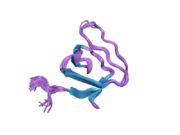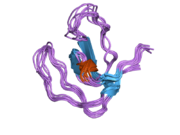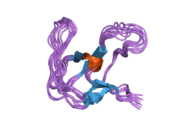- NCK2
-
Cytoplasmic protein NCK2 is a protein that in humans is encoded by the NCK2 gene.[1][2][3]
NCK belongs to family of adaptor proteins,There are two mammalian NCK genes.NCK1 and NCK2. NCK2 is also known as NCKBeta/Grb4. NCK/NCK1/NCKalpha, which is located in chromosome 3 and NCK2 is located in chromosome 2 respectively. The protein contains three SH3 domains and one SH2 domain. The protein has no known catalytic function but has been shown to bind and recruit various proteins involved in the regulation of receptor protein tyrosine kinases. It is through these regulatory activities that this protein is believed to be involved in cytoskeletal reorganization. Alternate transcriptional splice variants, encoding different isoforms, have been characterized.[3]
Contents
Interactions
NCK2 has been shown to interact with LIMS1,[4][5] Epidermal growth factor receptor,[1][5][6] PDGFRB,[1][6][7] PTK2,[8] T-cell surface glycoprotein CD3 epsilon chain[9] and TrkB.[10]
References
- ^ a b c Chen M, She H, Davis EM, Spicer CM, Kim L, Ren R, Le Beau MM, Li W (Oct 1998). "Identification of Nck family genes, chromosomal localization, expression, and signaling specificity". J Biol Chem 273 (39): 25171–8. doi:10.1074/jbc.273.39.25171. PMID 9737977.
- ^ Liu J, Li M, Ran X, Fan JS, Song J (Jun 2006). "Structural insight into the binding diversity between the human Nck2 SH3 domains and proline-rich proteins". Biochemistry 45 (23): 7171–84. doi:10.1021/bi060091y. PMID 16752908.
- ^ a b "Entrez Gene: NCK2 NCK adaptor protein 2". http://www.ncbi.nlm.nih.gov/sites/entrez?Db=gene&Cmd=ShowDetailView&TermToSearch=8440.
- ^ Tu, Y; Li F, Goicoechea S, Wu C (Mar. 1999). "The LIM-Only Protein PINCH Directly Interacts with Integrin-Linked Kinase and Is Recruited to Integrin-Rich Sites in Spreading Cells". Mol. Cell. Biol. (UNITED STATES) 19 (3): 2425–34. ISSN 0270-7306. PMC 84035. PMID 10022929. http://www.pubmedcentral.nih.gov/articlerender.fcgi?tool=pmcentrez&artid=84035.
- ^ a b Tu, Y; Li F, Wu C (Dec. 1998). "Nck-2, a Novel Src Homology2/3-containing Adaptor Protein That Interacts with the LIM-only Protein PINCH and Components of Growth Factor Receptor Kinase-signaling Pathways". Mol. Biol. Cell (UNITED STATES) 9 (12): 3367–82. ISSN 1059-1524. PMC 25640. PMID 9843575. http://www.pubmedcentral.nih.gov/articlerender.fcgi?tool=pmcentrez&artid=25640.
- ^ a b Braverman, L E; Quilliam L A (Feb. 1999). "Identification of Grb4/Nckbeta, a src homology 2 and 3 domain-containing adapter protein having similar binding and biological properties to Nck". J. Biol. Chem. (UNITED STATES) 274 (9): 5542–9. doi:10.1074/jbc.274.9.5542. ISSN 0021-9258. PMID 10026169.
- ^ Chen, M; She H, Kim A, Woodley D T, Li W (Nov. 2000). "Nckβ Adapter Regulates Actin Polymerization in NIH 3T3 Fibroblasts in Response to Platelet-Derived Growth Factor bb". Mol. Cell. Biol. (UNITED STATES) 20 (21): 7867–80. doi:10.1128/MCB.20.21.7867-7880.2000. ISSN 0270-7306. PMC 86398. PMID 11027258. http://www.pubmedcentral.nih.gov/articlerender.fcgi?tool=pmcentrez&artid=86398.
- ^ Goicoechea, Silvia M; Tu Yizeng, Hua Yun, Chen Ka, Shen Tang-Long, Guan Jun-Lin, Wu Chuanyue (Jul. 2002). "Nck-2 interacts with focal adhesion kinase and modulates cell motility". Int. J. Biochem. Cell Biol. (England) 34 (7): 791–805. doi:10.1016/S1357-2725(02)00002-X. ISSN 1357-2725. PMID 11950595.
- ^ Gil, Diana; Schamel Wolfgang W A, Montoya María, Sánchez-Madrid Francisco, Alarcón Balbino (Jun. 2002). "Recruitment of Nck by CD3 epsilon reveals a ligand-induced conformational change essential for T cell receptor signaling and synapse formation". Cell (United States) 109 (7): 901–12. doi:10.1016/S0092-8674(02)00799-7. ISSN 0092-8674. PMID 12110186.
- ^ Suzuki, Shingo; Mizutani Masaharu, Suzuki Kenji, Yamada Masashi, Kojima Masami, Hatanaka Hiroshi, Koizumi Shinichi (Jun. 2002). "Brain-derived neurotrophic factor promotes interaction of the Nck2 adaptor protein with the TrkB tyrosine kinase receptor". Biochem. Biophys. Res. Commun. (United States) 294 (5): 1087–92. doi:10.1016/S0006-291X(02)00606-X. ISSN 0006-291X. PMID 12074588.
Further reading
- Li W, Hu P, Skolnik EY, et al. (1992). "The SH2 and SH3 domain-containing Nck protein is oncogenic and a common target for phosphorylation by different surface receptors". Mol. Cell. Biol. 12 (12): 5824–33. PMC 360522. PMID 1333047. http://www.pubmedcentral.nih.gov/articlerender.fcgi?tool=pmcentrez&artid=360522.
- Tu Y, Li F, Wu C (1999). "Nck-2, a Novel Src Homology2/3-containing Adaptor Protein That Interacts with the LIM-only Protein PINCH and Components of Growth Factor Receptor Kinase-signaling Pathways". Mol. Biol. Cell 9 (12): 3367–82. PMC 25640. PMID 9843575. http://www.pubmedcentral.nih.gov/articlerender.fcgi?tool=pmcentrez&artid=25640.
- Tu Y, Li F, Goicoechea S, Wu C (1999). "The LIM-Only Protein PINCH Directly Interacts with Integrin-Linked Kinase and Is Recruited to Integrin-Rich Sites in Spreading Cells". Mol. Cell. Biol. 19 (3): 2425–34. PMC 84035. PMID 10022929. http://www.pubmedcentral.nih.gov/articlerender.fcgi?tool=pmcentrez&artid=84035.
- Braverman LE, Quilliam LA (1999). "Identification of Grb4/Nckbeta, a src homology 2 and 3 domain-containing adapter protein having similar binding and biological properties to Nck". J. Biol. Chem. 274 (9): 5542–9. doi:10.1074/jbc.274.9.5542. PMID 10026169.
- Coutinho S, Jahn T, Lewitzky M, et al. (2000). "Characterization of Ggrb4, an adapter protein interacting with Bcr-Abl". Blood 96 (2): 618–24. PMID 10887126.
- Chen M, She H, Kim A, et al. (2000). "Nckβ Adapter Regulates Actin Polymerization in NIH 3T3 Fibroblasts in Response to Platelet-Derived Growth Factor bb". Mol. Cell. Biol. 20 (21): 7867–80. doi:10.1128/MCB.20.21.7867-7880.2000. PMC 86398. PMID 11027258. http://www.pubmedcentral.nih.gov/articlerender.fcgi?tool=pmcentrez&artid=86398.
- Tu Y, Kucik DF, Wu C (2001). "Identification and kinetic analysis of the interaction between Nck-2 and DOCK180". FEBS Lett. 491 (3): 193–9. doi:10.1016/S0014-5793(01)02195-0. PMID 11240126.
- Jahn T, Seipel P, Coutinho S, et al. (2001). "Grb4/Nckbeta acts as a nuclear repressor of v-Abl-induced transcription from c-jun/c-fos promoter elements". J. Biol. Chem. 276 (46): 43419–27. doi:10.1074/jbc.M107030200. PMID 11514578.
- Cowan CA, Henkemeyer M (2001). "The SH2/SH3 adaptor Grb4 transduces B-ephrin reverse signals". Nature 413 (6852): 174–9. doi:10.1038/35093123. PMID 11557983.
- Goicoechea SM, Tu Y, Hua Y, et al. (2002). "Nck-2 interacts with focal adhesion kinase and modulates cell motility". Int. J. Biochem. Cell Biol. 34 (7): 791–805. doi:10.1016/S1357-2725(02)00002-X. PMID 11950595.
- Suzuki S, Mizutani M, Suzuki K, et al. (2002). "Brain-derived neurotrophic factor promotes interaction of the Nck2 adaptor protein with the TrkB tyrosine kinase receptor". Biochem. Biophys. Res. Commun. 294 (5): 1087–92. doi:10.1016/S0006-291X(02)00606-X. PMID 12074588.
- Gil D, Schamel WW, Montoya M, et al. (2002). "Recruitment of Nck by CD3 epsilon reveals a ligand-induced conformational change essential for T cell receptor signaling and synapse formation". Cell 109 (7): 901–12. doi:10.1016/S0092-8674(02)00799-7. PMID 12110186.
- Song J, Vranken W, Xu P, et al. (2002). "Solution structure and backbone dynamics of the functional cytoplasmic subdomain of human ephrin B2, a cell-surface ligand with bidirectional signaling properties". Biochemistry 41 (36): 10942–9. doi:10.1021/bi025815u. PMID 12206665.
- Aspenström P (2002). "The WASP-binding protein WIRE has a role in the regulation of the actin filament system downstream of the platelet-derived growth factor receptor". Exp. Cell Res. 279 (1): 21–33. doi:10.1006/excr.2002.5576. PMID 12213210.
- Hafizi S, Alindri F, Karlsson R, Dahlbäck B (2003). "Interaction of Axl receptor tyrosine kinase with C1-TEN, a novel C1 domain-containing protein with homology to tensin". Biochem. Biophys. Res. Commun. 299 (5): 793–800. doi:10.1016/S0006-291X(02)02718-3. PMID 12470648.
- Strausberg RL, Feingold EA, Grouse LH, et al. (2003). "Generation and initial analysis of more than 15,000 full-length human and mouse cDNA sequences". Proc. Natl. Acad. Sci. U.S.A. 99 (26): 16899–903. doi:10.1073/pnas.242603899. PMC 139241. PMID 12477932. http://www.pubmedcentral.nih.gov/articlerender.fcgi?tool=pmcentrez&artid=139241.
- Velyvis A, Vaynberg J, Yang Y, et al. (2003). "Structural and functional insights into PINCH LIM4 domain-mediated integrin signaling". Nat. Struct. Biol. 10 (7): 558–64. doi:10.1038/nsb938. PMID 12794636.
- Hu Y, Fang X, Dunham SM, et al. (2004). "90-kDa ribosomal S6 kinase is a direct target for the nuclear fibroblast growth factor receptor 1 (FGFR1): role in FGFR1 signaling". J. Biol. Chem. 279 (28): 29325–35. doi:10.1074/jbc.M311144200. PMID 15117958.
- Ran X, Song J. (2005). "Structural insight into the binding diversity between the Tyr-phosphorylated human ephrinBs and Nck2 SH2 domain". J Biol Chem. 280 (19): 19205–12.. doi:10.1074/jbc.M500330200. PMID 15764601.
- Song J. (2003). "Tyrosine phosphorylation of the well packed ephrinB cytoplasmic beta-hairpin for reverse signaling. Structural consequences and binding properties". J Biol Chem. 278 (27): 24714–20.. doi:10.1074/jbc.M210625200. PMID 12606549.
External links
- Nck2 Info with links in the Cell Migration Gateway
PDB gallery 1u5s: NMR structure of the complex between Nck-2 SH3 domain and PINCH-1 LIM4 domain1wx6: Solution structure of the SH3 domain of the human cytoplasmic protein NCK21z3k: Structural Insight into the Binding Diversity between the Tyr-Phosphorylated Human EphrinBs and Nck2 SH2 Domain2b86: Solution structure of the first Src homology 3 domain of Nck22cia: HUMAN NCK2 SH2-DOMAIN IN COMPLEX WITH A DECAPHOSPHOPEPTIDE FROM TRANSLOCATED INTIMIN RECEPTOR (TIR) OF EPEC2frw: Solution structure of the second SH3 domain of human adaptor protein NCK22fry: Solution structure of the third SH3 domain of human NCK2 adaptor protein
This protein-related article is a stub. You can help Wikipedia by expanding it.








